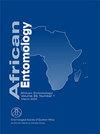Entomopathogenic fungi associated with cultivated honeybush, Cyclopia spp., in South Africa and their pathogenicity towards a leafhopper pest, Molopopterus sp. (Hemiptera: Cicadellidae)
IF 1.2
4区 农林科学
Q3 ENTOMOLOGY
引用次数: 0
Abstract
The southern and eastern parts of the African Fynbos region favour the production of honeybush tea. Honeybush biomass and extracts are used to prepare a beverage both locally and internationally, mainly as herbal tea with health benefits. Honeybush tea is mostly grown organically requiring natural control measures for pests and diseases. The leafhopper, Molopopterus sp., is one of the most important pests of cultivated honeybush in South Africa, as its feeding compromises the quality and quantity of the yield through leaf discolouration and reduction of the photosynthetic area. Local entomopathogenic fungi (EPF) can provide a pool of potential biocontrol agents for this pest. Therefore, a total of 98 soil samples were collected from organically grown honeybush fields and vegetation surrounding the honeybush fields in the Western Cape province of South Africa. Entomopathogenic fungi were isolated using the insect bait method and were characterised using molecular techniques. Twenty fungal isolates of Metarhizium anisopliae and Fusarium oxysporum were recovered from soil samples, of which 70% were from honeybush fields and 30% were from surrounding vegetation. Fusarium oxysporum isolates comprised 20% of the recovered isolates; M. anisopliae the remainder. Laboratory bioassays of the recovered isolates against adults and nymphs of the leafhopper, showed that F. oxysporum isolates caused 10–45% mortality and M. anisopliae isolates 30–80% mortality. Metarhizium anisopliae isolates J S1, KF S3, KF S11, KF S13, LS1 and LS2 were the most virulent and induced over 60% mortality in both nymphs and adults at a concentration of 1 × 107 conidia/ml.与南非栽培的蜜蜂Cyclopia sp.有关的昆虫病原真菌及其对叶蝉Molopopterus sp.的致病性(半翅目:蝉科)
非洲Fynbos地区的南部和东部地区有利于蜜树茶的生产。Honeybush生物质和提取物在当地和国际上都被用于制备饮料,主要是作为具有健康益处的凉茶。蜂蜜茶大多是有机种植的,需要对病虫害采取自然控制措施。叶蝉Molopopterus sp.是南非栽培蜜树中最重要的害虫之一,因为它的取食会使叶片变色和光合面积减少,从而影响产量的质量和数量。当地昆虫病原真菌(EPF)可以为这种害虫提供潜在的生物防治剂。因此,共从南非西开普省有机种植的蜜树田和蜜树田周围的植被中采集了98个土壤样本。采用虫饵法分离昆虫病原真菌,并利用分子技术对其进行了表征。从土壤样品中分离到20株绿僵菌和尖孢镰刀菌,其中70%来自蜜丛地,30%来自周围植被。尖孢镰刀菌分离株占回收分离株的20%;M.anisopliae剩余部分。对回收的分离株进行的针对叶蝉成虫和若虫的实验室生物测定表明,尖孢镰刀菌分离株造成10-45%的死亡率,绿脓杆菌分离株造成30-80%的死亡率。绿僵菌菌株J S1、KF S3、KF S11、KF S13、LS1和LS2在1×107分生孢子/ml的浓度下对若虫和成虫的致死率均超过60%。
本文章由计算机程序翻译,如有差异,请以英文原文为准。
求助全文
约1分钟内获得全文
求助全文
来源期刊

African Entomology
生物-昆虫学
CiteScore
2.00
自引率
0.00%
发文量
17
审稿时长
6-12 weeks
期刊介绍:
African Entomology (ISSN 1021-3589 – print / 2224-8854 – online) replaced the old Journal of the Entomological Society of Southern Africa in 1993. A single volume consisting of two issues (March and September) is published annually. The journal is indexed in all major abstracting journals
African Entomology is a peer reviewed scientific journal that publishes original research articles and short communications on all aspects of entomology, with an emphasis on the advancement of entomology on the African continent.
 求助内容:
求助内容: 应助结果提醒方式:
应助结果提醒方式:


